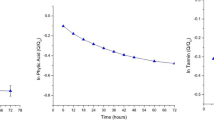Abstract
This study was designed to determine the effect of soaking, sprouting, fermentation and cooking on nutrient composition and some antinutritional factors of sorghum seeds (guineesia). Standard assay procedures were adopted to resolve both the nutrients and the antinutritional factors content of the products. Combination of cooking and fermentation improved the nutrient quality and drastically reduced the antinutritional factors to safe levels much greater than any of the other processing methods tested.
Similar content being viewed by others
References
Haikerwal M, Matheson AR (1971) The protein content and amino acid composition of sorghum grain. Am Assoc Cereal Chem 48: 690–95
Obizoba IC (1988) Nutritive value of malted dry or wet milled sorghum and corn. Cereal Chem 65: 447–449
Olatunji O, Akinrele IA, Edwards CO, Koleoso OA (1982) Sorghum and millet processing and uses in Nigeria. Cereal Fd Wld 27: 277
Akingbelu JO, Rooney LW, Faubion JM (1981) Physical chemical and sensory evaluation of ogi from sorghum of differing kernel characteristics. J Food Sci 46:1532–36
Wang YYD, Fields ML (1978) Germination of corn and sorghum in the home to improve nutritive value. J Food Sci 43: 113–115
Panasuik O, Bills DD (1984) Cyanide contents of sorghum sprouts. J Food Sci 49: 791–793
AOAC (1980) Official Methods of Analysis. 13th edn. Washington, DC: Association of Official Analytical Chemists
Chavan JK, Kaan SS, Salunke DK (1981) Changes in tannin, free fatty acids, reducting sugar and starch during seed germination of low and high tannin cultivars of sorghum. J Food Sci 46: 638–39
Gorz HJ, Haag NL, Specht JE, Haskins FA (1977) Assay of P-hydroxyubernaldehyde as a measure of hydrocyanic acid potential in sorghums. Crop Sci 17: 578–582
Oke OL (1969) The role of hydrocyanic acid in nutrition. Wld Rev Nutr Diet 11: 118–147
Oke OL (1979) Some aspects of the role of cyanogenic glucosides in nutrition. Wld Rev Nutr Diet 33: 70–103
Jyothbi E, Reddy PR (1981) Effect of germination and cooking on the in vitro digestibility of starch in some legume. Nutr Rept Int 23: 79–80
Rahma EH, Aal MH (1986) Changes in gross chemical composition with emphasis on lipid and protein fractions during germination of Fenugreek seeds. Food Chem 22: 193–207
Harwood JL, Stumpt PK (1970) Fat metabolism in higher plants. XL. Synthesis of fatty acids in the initial stage of seed germination. Plant Physiol 46: 500
Wu YV, Wall JS (1980) Lysine content of protein increased by germination of normal and high lysine sorghum. J Agric Food Chem 28: 455–458
Hamad AM, Fields ML (1979) Evaluation of the protein quality and available lysine of germinated and fermented cereals. J Food Sci 44: 456–59
Chen LH, Wells CC, Fordham JR (1975) Germinated seeds for human consumption. J Food Sci 40: 1290–93
Ogunsua AO (1980) Changes in some chemical constituent during fermentation of cassava tubers (Manihot esculenta, (rantz). Food Chem 5: 249–255
Osuntakun BO (1981) Cassava diet chronic cyanide intoxication and neurepathy in Nigerian Africans. Wld Rv Nutr Diet 36: 141–173
Kazanas N, Fields ML (1981) Nutritional improvement of sorghum by fermentation. J Food Sci 46: 819–21
Rao DS, Deosthale YG (1983) Mineral composition, ionizable iron and soluble zinc in malted grains of pearl millet and ragi. Food Chem 11: 217–223
Heerden IV, Glennie CW (1987) Availability of B-vitamins in sorghum beer. Nutr Rept Int 35: 1–3
Murata K, Ikehata H, Miyamoto T (1967) Studies on the nutritional value of tempeh. J Food Sci 32: 580
Author information
Authors and Affiliations
Rights and permissions
About this article
Cite this article
Obizoba, I.C., Atii, J.V. Effect of soaking, sprouting, fermentation and cooking on nutrient composition and some anti-nutritional factors of sorghum (Guinesia) seeds. Plant Food Hum Nutr 41, 203–212 (1991). https://doi.org/10.1007/BF02196388
Received:
Accepted:
Issue Date:
DOI: https://doi.org/10.1007/BF02196388




